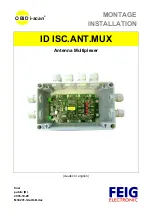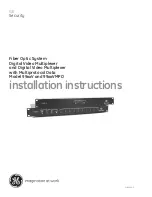
2
3
Input Protection Limits
Function
Maximum Input
V dc or V ac
1000Vdc/ac RMS
mA ac/dc
800mA 1000V fast acting fuse
A ac/dc
10A 1000V fast acting fuse
Frequency,Resistance, Capacitance
Duty Cycle,DiodeTest,Continuity
1000Vdc/ac rms
Temperature
1000Vdc/ac rms
Surge Protection: 8kV peak per IEC 61010
PER IEC1010 OVERVOLTAGE INSTALLATION CATEGORY
OVERVOLTAGE CATEGORY I
Equipment of OVERVOLTAGE CATEGORY I is equipment for connection to circuits in which measures
are taken to limit the transient overvoltages to an appropriate low level.
Note – Examples include protected electronic circuits.
OVERVOLTAGE CATEGORY II
Equipment of OVERVOLTAGE CATEGORY II is energy-consuming equipment to be supplied from the
fixed installation.
Note – Examples include household, office, and laboratory appliances.
OVERVOLTAGE CATEGORY III
Equipment of OVERVOLTAGE CATEGORY III is equipment in fixed installations.
Note – Examples include switches in the fixed installation and some equipment for industrial use with
permanent connection to the fixed installation.
OVERVOLTAGE CATEGORY IV
Equipment of OVERVOLTAGE CATEGORY IV is for use at the origin of the installation.
Note – Examples include electricity meters and primary over-current protection equipment
2.2.Safety Instructions
This meter has been designed for safe use, but must be operated with caution.
The rules listed below must be carefully followed for safe operation.
• NEVER apply voltage or current to the meter that exceeds the specified maximum:
• USE EXTREME CAUTION when working with high voltages.
• DO NOT measure voltage if the voltage on the “COM” input jack exceeds 1000V above earth ground.
• NEVER connect the meter leads across a voltage source while the function switch is in the current,
resistance, or diode mode. Doing so can damage the meter.
• ALWAYS discharge filter capacitors in power supplies and disconnect the power when making
resistance or diode tests.
• ALWAYS turn off the power and disconnect the test leads before opening the covers to replace the
fuse or batteries.
• NEVER operate the meter unless the back cover and the battery and fuse covers are in place and
fastened securely.
If the equipment is used in a manner not specified by the manufacturer, the protection provided by the
equipment may be impaired.
3.Discription and reference guide
3.1.Front and back descriptions
1-NCV detector area
2-LCD Display
3-Navigation/Menu buttons
4-MODE button
5-RANGE button
6-Rotary function switch
7-Po) Probe input jack for A (Current).
8-Po) Probe input jack for mA (Current).
9-COM(-) Probe input jack
10-Po) Probe input jack for all Inputs except A and mA
11-Thermal mode/Light button
12-Hold/Capture button
Fig 3.1 Front view
Fig 3.2 Back view
1-No-slip slope
2-Thermal imager Len
3-Len cover
4-Work light
5-Laser
6-Support plate
7-Battery cover lock
True RMS Thermal MultiMeter / English
True RMS Thermal MultiMeter / English
19/07/2018 Version No. 001
19/07/2018 Version No. 001




































